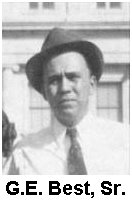March 21,
1952:
Judsonia's brief
season in hell
By BOB SALLEE
Arkansas Democrat-Gazette, April 23, 1998
Yep, it's unwise
to tempt Mother Nature. The ink was hardly dry on last week's
glance at some of the worst hail storms in Arkansas when, as fate
decreed, hailstones the size of large agates suddenly started
raining down on parts of the Natural State.
A deafening clatter, like the din of a rock-slide,
pounded the roof and the skylights in our digs on the top floor
of the Democrat-Gazette building downtown at Capitol Avenue and
Scott Street. Then that small inner voice cautioned: "Don't
write about tornadoes just now."
But the die was already cast for this backward
glance at a swarm of killer tornadoes that struck 10 towns from
southwest to northeast across Arkansas late on the afternoon of
March 21, 1952.
The ghastly toll in human agony was shocking.
The body count was 115. The names of more than 800 people were
listed in emergency rooms of hospitals in the stricken parts of
the state, and property losses exceeded $25 million.
Twisters had churned first through Dierks
and Center Point in Howard County. England and Carlisle in central
Arkansas also got hit. And Judsonia was practically wiped off
the map. The other towns in harm's way as the monster storm cell
hopscotched across the state were Bald Knob, Augusta, Cotton Plant,
Trumann and Manila, the little town where two youngsters were
killed in last week's tornado. An old-timer watching the cleanup
there after last week's devastation winced while recalling that
dark interlude 46 years ago. Weather observers speculated that
at least three tornadoes had been spawned as the storm cell moved
across the state.
He was barely a teen-ager at the time, but
G. Edwin Best Jr. vividly recalls accompanying his father to help
with rescue efforts around Judsonia. He's president of the White
County Historical Society.
His father, the late Grover Edwin Best,
was a salesman in the early 1950s. In later years, he was a delinquent
tax collector in Pulaski County. Another son, Ken Best, was sheriff
of Pulaski County in the 1970s.
Eddie Best and his wife, Pat, moved to Searcy
in the fall of 1995. They were immediately impressed with the
easygoing nature of White County residents, and with an unusual
feature of the surrounding landscape: Many homes in the neighborhood
they had selected, and elsewhere, had a tornado shelter in the
back yard - a "fraidy hole" in the local vernacular.
The security of a storm shelter in those climes is a carryover
from the 1952 storm. Sophisticated radar systems were yet to be
developed for tracking and monitoring up-to-the-minute changes
in the weather.
NOWHERE TO HIDE

At the time, Grover Best and his family lived in North Little
Rock. He was a sales representative for a company that built ambulances
and hearses. When authorities issued an appeal throughout central
Arkansas for additional ambulances, he gassed up his new demonstrator
ambulance and headed for White County with 14-year-old Eddie riding
along as a stretcher-bearer.
Much of Judsonia lay in ruins. Familiar businesses had been reduced
to rubble. What was left of the local roller rink - the social
center for most kids around Judsonia - laid flattened on the ground.
Father and son spent the night helping storm victims and shuttling
them to nearby hospitals. Many of the victims they transported
were found in Judsonia, but some were picked up in outlying communities.
DAWN OVER DISASTER
Eddie Best remembers daybreak and the sun rising over the devastated
town. Armed soldiers were on every street corner and military
jeeps were parked here and there. National Guardsmen were on patrol.
"Seeing the buildings in rubble, and soldiers in the streets,"
Best recalls, "it looked just like the newsreels of World
War II."
In his book That's Judsonia five years later,
W.E. Orr wrote that the tornado struck "precisely at 5:34
p.m., totally unexpected, and howling like a multitude of madmen."
He described the tornado as sounding like "the bellowing
of 10,000 demons seemingly unleashed at the end of the world."
A man hunkered over his baby son in a doorway,
his back to the approaching storm. His wife had yelled a warning
after seeing debris flying around in the air. The family escaped
with their lives but pressure created by the vacuum, and what
might have been wind shear, sucked half the native stones off
the outer walls of the house. (Unscathed, the child became a successful
engineer in Conway.)
The sky took on an orange glow just before
the twister began its rampage through town. After a short lull,
a hard-driving rain pelleted the rubble as the color of the sky
darkened to pitch black.
Orr wrote:
Afterward, they were to remember the
silence - that, and the eerie yellow twilight. All over the stricken
town people felt the clutch of that silence, almost as fearsome
as had been the roaring a few minutes before. There was not a
bird's call, not a human voice, not the sound of a single automobile.
It was like the stillness of a huge tomb whose occupants had belonged
to another age. Then it was broken - then came the sound effects
for the dirty dusk. A woman screamed, slashing the silence like
a blade.
An old man, his face contorted with shock,
walked up to a neighbor, shook his head sadly, and muttered: "It's
done blowed the whole town away."
That dark chapter in the history of Judsonia
is remembered by those who were there. Memory serves as a memorial,
not just to those whose lives were suddenly ended, or forever
changed, but to the multitude who escaped with their lives.
